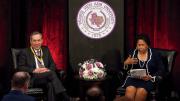A year after Harvard released a report detailing its historical connections to slavery and pledged $100 million toward a series of reparative steps, the work of fulfilling those recommendations has started to take shape (see harvardmag.com/after-report-22). Last fall, the University announced that attorney and scholar Richard Cellini had been appointed to lead a remembrance program tasked with identifying the descendants of people who were once enslaved on Harvard’s campus or by Harvard affiliates. Previously, Cellini led the research institute that helped locate direct descendants of the enslaved people sold in 1838 to raise funds for Georgetown University. At Harvard, his tasks are focused on enabling descendants to “recover their histories, tell their stories, and pursue empowering knowledge.”
In recent months, the University has made additional appointments and announcements regarding a planned campus memorial to the enslaved, partnerships with historically black educational institutions, and other actions recommended by the Presidential Committee on Harvard and the Legacy of Slavery, which spent two years compiling the report.
In February, Sara Bleich, the newly appointed vice provost for special projects, who is charged with overseeing efforts to fulfill the report’s recommendations, outlined her initial priorities. A professor of public health policy who spent the prior two years in Washington, D.C., working with the U.S. Department of Agriculture, she talked about both the gravity and promise of the work ahead, for which there is no predetermined roadmap. “We have to figure out, based on our history, based on our resources, based on the conversations that we are having,” she said in an interview, how “to drive into this white space, and do it in a way that really allows us to reckon with our history, but then also puts us on a path to repair….I don’t know of another opportunity where there is a chance to change Harvard for the better the way this initiative has the potential to do.” Her team’s main priorities for the 2023-2024 academic year involve creating what she called “institutional muscle”: hiring staff, building tools for communication and collaboration, and strengthening infrastructure—plus: a lot of listening to university and community members. Key questions at this early stage, she said, are: “What is already happening, and how can we build on that?”(Read more at harvardmag.com/reckoning-23.)
Among other recent steps:
A memorial. In early February, Harvard named a 13-member committee to lead efforts to build a memorial for the enslaved (per the report’s recommendation that the University “honor the enslaved people whose labor facilitated the founding, growth, and evolution of Harvard through a permanent and imposing physical memorial, convening space, or both”). The committee is co-chaired by Tracy K. Smith, professor of English and African and African American studies and Wallach professor at the Radcliffe Institute, and Dan Byers, the Robinson Family director of the Carpenter Center for the Visual Arts.
The senior adviser. In late February, Harvard announced the appointment of Ruth Simmons, Ph.D. ’73, LL.D. ’02, as senior adviser to the president on engagement with Historically Black Colleges and Universities (HBCUs). Set to begin June 1, she will advise Harvard on the development and growth of “enduring partnerships” with HBCUs, including faculty and student exchanges between Harvard and HBCU institutions. This fall, she will convene a gathering of HBCUs in Cambridge.
Simmons’s experience in this area is considerable. As president of Brown University in the early 2000s, she launched an investigation into its historical connections to slavery—the first inquiry of its kind. The Brown University Steering Committee on Slavery and Justice produced a landmark report in 2006 that became a model for dozens of other institutions—including Harvard—that have since begun examining their own histories of slavery. From 2017 until her retirement this year, she served as president of Prairie View A&M University, an HBCU near Houston. In a virtual address given at Harvard’s 2021 graduation, she spoke in strong terms of the longstanding inequalities HBCUs have endured: “I call on universities like Harvard to acknowledge the limitations imposed on these institutions over the past decades,” she said. “While universities like Harvard had the wind at their back, flourishing from endowments, strong enrollments, constant curricular expansion, massive infrastructure improvements, and significant endowment growth, HBCUs often had gale-force winds impeding their development.”
On the day her appointment was announced, Simmons sat down with Harvard President Lawrence S. Bacow for an hourlong conversation at Prairie View A&M. Noting the “direct role” that Simmons, as president of Brown, had played in inspiring Harvard’s later self-investigation, Bacow said, “She really plowed new ground. And she set an example for all of us.” Later in the discussion, Simmons said, “This is the moment for HBCUs to receive their fair share.” (Read more harvardmag.com/simmons-adviser-23.)
Working with HBCU libraries. In early March, the University announced a partnership between the HBCU Library Alliance and Harvard Library, aimed at digitizing and preserving African American history collections in HBCU libraries and archives. The four-year, $6-million project will bolster the digital library hosted by the Atlanta University Center Robert W. Woodruff Library, which serves the oldest consortium of HBCUs: Clark Atlanta University, the Interdenominational Theological Center, Morehouse College, and Spelman College. The new partnership will scale up and strengthen the library’s digital capacity, extending training, resources, and servic es. Once photos and documents are digitized, public access to finding aids and collections will be available through the HBCU Library Alliance digital library portal. Harvard Vice President for the Library and University Librarian Martha Whitehead will lead the University’s side of the partnership.
Reaching descendant communities. Bleich said that work has begun on other recommendations, including one that called on Harvard to partner with K-12 schools, community colleges, tribal colleges, universities, and nonprofit organizations to “leverage its scholarly excellence and expertise in education to confront systemic and enduring inequities” affecting descendant communities. This is “probably an area where we have the most opportunity,” she said. She also stressed efforts taking place within individual schools at Harvard. In January, for example, the Law School announced a partnership with the Royall House and Slave Quarters in Medford, which includes a $500,000 gift to support the museum (learn more at harvardmag.com/law-royall-23). And this winter, the Harvard Divinity School held a series of online public conversations exploring religion and the legacies of slavery. “This type of work is so important,” Bleich said, “because for us to propel this work forward, we need to embed these activities in the DNA of the University.”
Teaching the report. That was the aim of one other localized effort: a two-day conference in February, during which faculty members and teaching staff discussed how to integrate the report’s findings into their own curricula. Hosted by the Derek Bok Center for Teaching and Learning, the event, titled “Harvard and the Legacy of Slavery: From the Committee Report to the Classroom,” drew participants from history, literature, classics, anthropology, music, medicine, the Graduate School of Education, the Graduate School of Design, Harvard’s libraries, and the Harvard Art Museums, among others. (Read a full report at harvardmag.com/teaching-slavery-23.)
The program’s six speakers were all scholars who had helped lead efforts to uncover their own institutions’ past entanglements with slavery: Princeton historian Martha A. Sandweiss ’75, University of Pennsylvania historian Kathleen M. Brown, Georgetown historian Adam Rothman, and cultural studies scholar Laura Goldblatt from the University of Virginia. Speaking from Harvard were Warren professor of American history and professor of African and African American studies Vincent Brown, who served on the presidential committee that produced Harvard’s report; and Bell professor of history Sven Beckert, who in 2007 began teaching a series of undergraduate seminars that eventually sparked the University’s own research project. Beckert and his students unearthed many of the revelations that would make their way into the report. “For me, personally, this was the most rewarding teaching I’ve ever done in my life,” he said of those seminars.
Speakers talked about the challenges—and triumphs—in teaching this material, the importance of institutional support, and methods for turning students’ archival research into public narratives. One recurring theme was the idea that students in these courses are not merely learners but “producers” and “creators” of knowledge. “When you teach these kinds of courses, you’re not dreading the moment when you have to grade the paper; it’s just the opposite,” Beckert said. “You can’t wait to read the paper, because there’s going to be something in it that you don’t know, that is probably going to make you rethink the problem that you’re engaging with.”
Later, when an audience member asked how to handle the fact that traumatic histories might disproportionately affect students whose family lineages and ethnic backgrounds are implicated, Beckert’s answer pointed toward the University’s current reparative process. “There were moments when we all had tears in our eyes when the students reported certain really horrific things that they found in the archives,” he said. “There were moments of silence in our conversation when nobody really knew what to say next.” It helped, he added, that the research was part of a larger active push—first, for recognition from the University and, ultimately, for a process of reckoning and repair, which is now under way. “It wasn’t just learning about terrible things in the past; we also did something about it,” Beckert concluded. “We produced knowledge that we hoped would make a difference.”









